Top Rankings
Marlboro School District ranks among the top 20% of public school district in Vermont for:
Category
Attribute
Diversity
Most diverse schools (Top 1%)
Student Attention
Lowest student:teacher ratio (Top 1%)
For the 2025 school year, there is 1 public school serving 80 students in Marlboro School District. This district's average testing ranking is 7/10, which is in the top 50% of public schools in Vermont.
Public School in Marlboro School District have an average math proficiency score of 34% (versus the Vermont public school average of 33%), and reading proficiency score of 44% (versus the 44% statewide average).
Minority enrollment is 13% of the student body (majority Black and Asian), which is equal to the Vermont public school average of 13% (majority Hispanic and Black).
Overview
This School District
This State (VT)
# Schools
1 School
306 Schools
# Students
80 Students
78,642 Students
# Teachers
9 Teachers
7,167 Teachers
Student : Teacher Ratio
9:1
9:1
District Rank
Marlboro School District, which is ranked within the top 50% of all 102 school districts in Vermont (based off of combined math and reading proficiency testing data) for the 2021-2022 school year.
Overall District Rank
#51 out of 154 school districts
(Top 50%)
(Top 50%)

Math Test Scores (% Proficient)
35%
33%
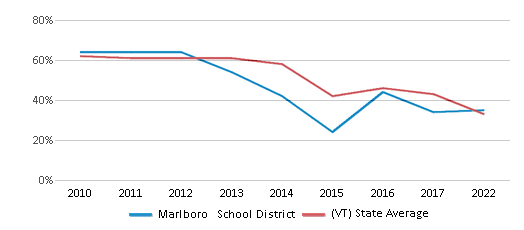
Reading/Language Arts Test Scores (% Proficient)
45%
44%

Science Test Scores (% Proficient)
30%
35%
Students by Ethnicity:
Diversity Score
0.23
0.23
# American Indian Students
1 Student
202 Students
% American Indian Students
1%
n/a
# Asian Students
3 Students
1,604 Students
% Asian Students
4%
2%
# Hispanic Students
1 Student
2,652 Students
% Hispanic Students
1%
3%
# Black Students
4 Students
2,114 Students
% Black Students
5%
3%
# White Students
70 Students
68,754 Students
% White Students
88%
88%
# Hawaiian Students
n/a
56 Students
% Hawaiian Students
n/a
n/a
# Two or more races Students
1 Student
3,304 Students
% of Two or more races Students
1%
4%
Students by Grade:
# Students in PK Grade:
8
8,002
# Students in K Grade:
8
5,145
# Students in 1st Grade:
4
5,342
# Students in 2nd Grade:
14
5,706
# Students in 3rd Grade:
7
5,327
# Students in 4th Grade:
5
5,812
# Students in 5th Grade:
10
5,556
# Students in 6th Grade:
9
5,670
# Students in 7th Grade:
8
5,534
# Students in 8th Grade:
7
5,596
# Students in 9th Grade:
-
5,400
# Students in 10th Grade:
-
5,537
# Students in 11th Grade:
-
5,331
# Students in 12th Grade:
-
4,684
# Ungraded Students:
-
-
District Revenue and Spending
The revenue/student of $41,438 is higher than the state median of $29,860. The school district revenue/student has grown by 12% over four school years.
The school district's spending/student of $39,750 is higher than the state median of $29,121. The school district spending/student has grown by 12% over four school years.
Total Revenue
$3 MM
$2,348 MM
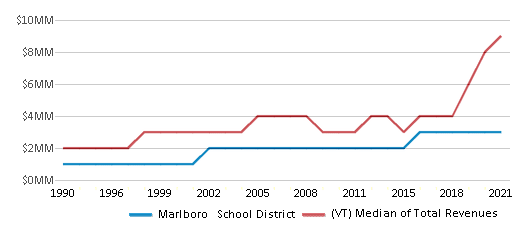
Spending
$3 MM
$2,290 MM
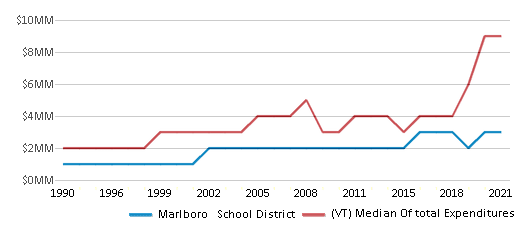
Revenue / Student
$41,438
$29,860
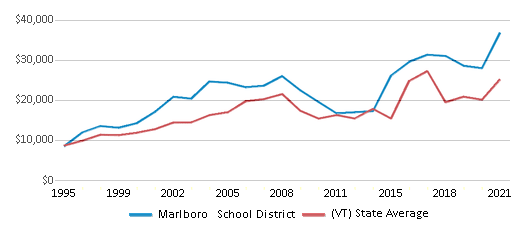
Spending / Student
$39,750
$29,121
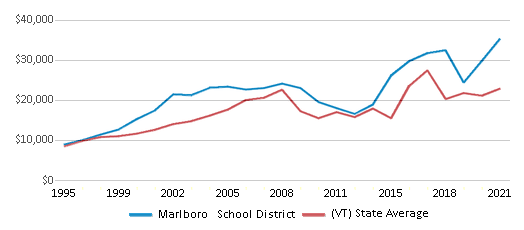
Best Marlboro School District Public Schools (2025)
School
(Math and Reading Proficiency)
(Math and Reading Proficiency)
Location
Grades
Students
Rank: #11.
Marlboro Elementary School
(Math: 30-39% | Reading: 40-49%)
Rank:
Rank:
6/
Top 50%10
2669 Route 9
Marlboro, VT 05344
(802) 254-2668
Marlboro, VT 05344
(802) 254-2668
Grades: PK-8
| 80 students
Frequently Asked Questions
How many schools belong to Marlboro School District?
Marlboro School District manages 1 public schools serving 80 students.
What is the rank of Marlboro School District?
Marlboro School District is ranked #35 out of 102 school districts in Vermont (top 50%) based off of combined math and reading proficiency testing data for the 2021-2022 school year. This district ranks in the top 20% of Vermont school districts for: Most diverse schools (Top 1%) and Lowest student:teacher ratio (Top 1%)
What is the racial composition of students in Marlboro School District?
88% of Marlboro School District students are White, 5% of students are Black, 4% of students are Asian, 1% of students are American Indian, 1% of students are Hispanic, and 1% of students are Two or more races.
What is the student/teacher ratio of Marlboro School District?
Marlboro School District has a student/teacher ratio of 9:1, which is lower than the Vermont state average of 11:1.
What is Marlboro School District's spending/student ratio?
The school district's spending/student of $39,750 is higher than the state median of $29,121. The school district spending/student has grown by 12% over four school years.
Recent Articles

Year-Round Or Traditional Schedule?
Which is more appropriate for your child? A year-round attendance schedule or traditional schedule? We look at the pros and cons.

Why You Should Encourage Your Child to Join a Sports Team
Participating in team sports has a great many benefits for children, there is no doubt. In this article you will learn what those benefits are.

White Students are Now the Minority in U.S. Public Schools
Increasing birth rates among immigrant families from Asia and Central and South America, combined with lower birth rates among white families, means that for the first time in history, public school students in the United States are majority-minority. This shift in demographics poses difficulties for schools as they work to accommodate children of varying language abilities and socio-economic backgrounds.





